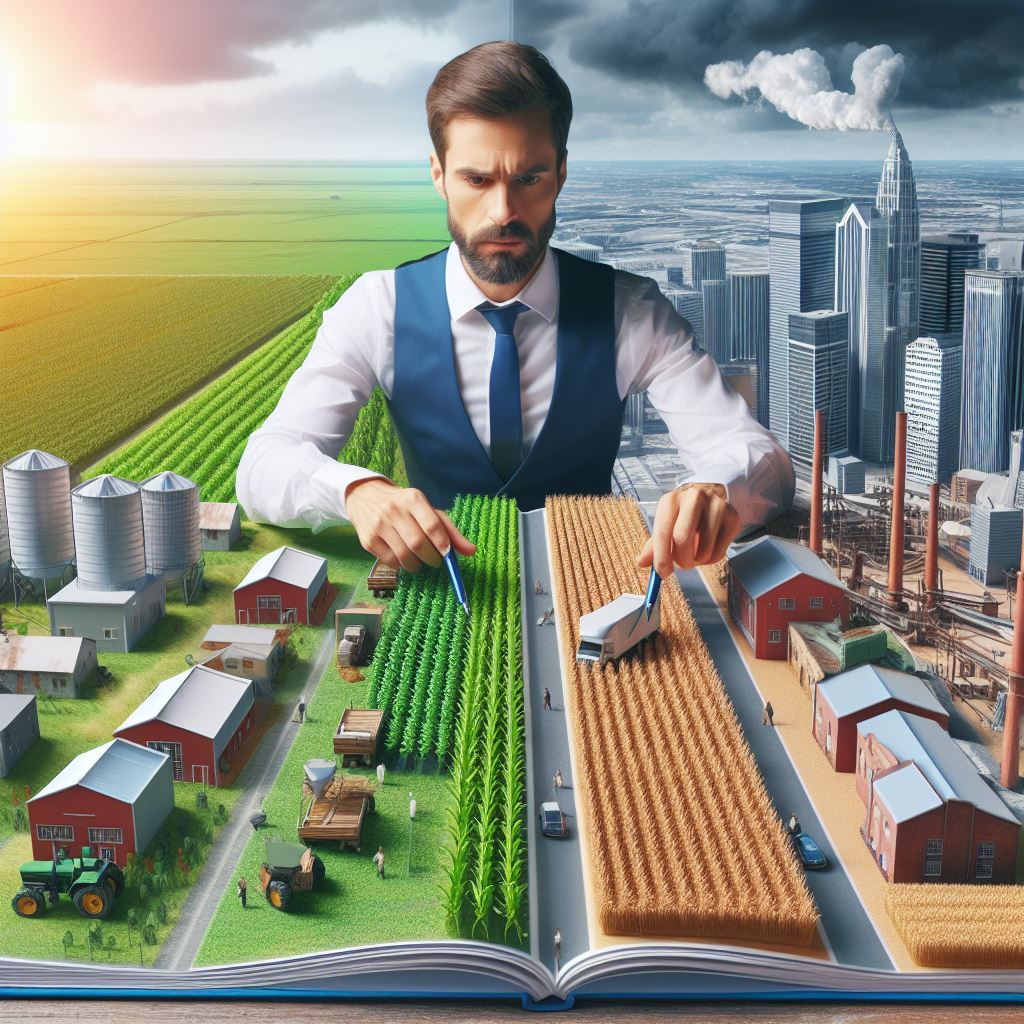Introduction
In 2024, US farm policy experienced seismic shifts, altering the agricultural terrain dramatically.
This transformation holds immense significance as it affects numerous stakeholders, from farmers to consumers.
The policy changes ripple through the economy, influencing food production, pricing, and distribution channels.
Moreover, US farm policy intersects with environmental concerns, impacting land use, water management, and sustainability efforts.
Additionally, it plays a pivotal role in international trade dynamics, shaping global markets and geopolitical relationships.
Understanding the nuances and implications of these shifts is crucial for policymakers, economists, farmers, and consumers alike.
As we delve into the intricacies of the evolving US farm policy landscape, it becomes apparent that its implications extend far beyond the agricultural sector, touching upon broader socio-economic and environmental domains.
Thus, exploring the significance of US farm policy in 2024 unveils a multifaceted tapestry of interconnected issues with far-reaching consequences.
Read: Pesticide Regulations in Modern Farming
Overview of the current state of US farm policy
Briefly discuss the main components and goals
The US farm policy revolves around supporting and regulating agricultural activities to ensure food security, economic stability, and environmental sustainability.
Its main components include subsidies, price supports, and conservation programs.
- Subsidies: The government provides financial aid to farmers to help them offset production costs, manage risks, and remain competitive in the global market. These subsidies aim to stabilize farm income and ensure a stable food supply.
- Price supports: The government implements price support programs to guarantee minimum prices for crops like wheat, corn, and soybeans. By setting price floors, farmers are protected from market fluctuations and can make informed decisions regarding production.
- Conservation programs: Farm policy also emphasizes environmental protection and sustainability. Through various conservation programs, farmers are encouraged to adopt practices that reduce soil erosion, protect water quality, and preserve wildlife habitats.
Recent developments or changes
- Shift towards sustainable practices: In recent years, there has been a growing focus on promoting sustainable farming practices. The government has introduced incentives for farmers to adopt conservation techniques, such as cover cropping and precision agriculture, to reduce environmental impact.
- Increased support for diversified farming: Recognizing the importance of diversification in building resilient agricultural systems, the US farm policy has started encouraging farmers to explore alternative crops and livestock, such as organic farming or niche markets. This promotes innovation and reduces reliance on a single commodity.
- Trade complexities: The current state of US farm policy is also influenced by ongoing trade complexities. Tariffs and trade disputes have disrupted traditional export markets, leading to instability in the agricultural sector. Policies have been adjusted accordingly to mitigate the impact on farmers.
- Renewable energy incentives: With a growing emphasis on renewable energy, the farm policy has integrated incentives for farmers to produce biomass, biofuels, and wind or solar energy on their lands. This not only diversifies income sources for farmers but also contributes to national energy goals.
- Technology adoption: Agricultural technology has become an integral part of the US farm policy. The government aims to boost productivity and efficiency by promoting the adoption of advanced technologies like precision farming, robotics, and data analytics.
In fact, the current state of US farm policy revolves around supporting farmers in achieving economic stability, environmental sustainability, and food security.
It entails subsidies, price supports, and conservation programs. Recent developments include a focus on sustainability, diversification, trade complexities, renewable energy, and technology adoption.
These shifts lay the foundation for a more resilient and innovative agricultural sector in the coming years.
Read: Impact of Tax Laws on Family Farms
Analysis of expected shifts in US farm policy by 2024
Economic factors influencing policy changes
By 2024, economic factors, political considerations, and government programs will significantly shift the future of US farm policy.
These changes will shape the way agriculture is practiced and supported in the country.
Economically, global trade dynamics will play a crucial role in determining farm policy.
As trade agreements evolve and tariffs are imposed, the agricultural sector will need to adapt to remain competitive.
Technological advancements in agriculture, such as precision farming and data analytics, will also drive policy changes, as the industry becomes more efficient and sustainable.
Environmental concerns and sustainability will be given increased attention in farm policy decisions.
The impact of climate change and the need for sustainable practices will shape agricultural practices and regulations.
This may include incentives or regulations to reduce greenhouse gas emissions, improve soil health, and conserve water resources.
Political considerations shaping the future policy
Politically, shifts in party dynamics and priorities will influence the future of farm policy.
As party ideologies evolve, so too will their stance on agricultural issues.
The influence of interest groups and lobbying efforts will also shape policy decisions, as they work to advocate for the interests of farmers and agriculture-related industries.
Additionally, voter sentiments and demands will have a significant impact on policy choices, particularly with regards to food safety, consumer preferences, and local agriculture.
Government programs and subsidies likely to be impacted
Government programs and subsidies will likely see changes in the coming years.
Reevaluating crop insurance and risk management programs may impact farmers’ access to coverage and its extent.
Conservation and land stewardship initiatives will also be a focal point, as efforts to protect and preserve natural resources become increasingly important.
Government programs may increase support for small-scale and organic farming practices, meeting the demand for sustainable, locally sourced products.
In short, the expected shifts in US farm policy by 2024 will be influenced by economic factors, political considerations, and government programs.
It is crucial to anticipate these changes and adapt to new policies to ensure the continued success and sustainability of the agricultural sector.
Read: Farmland Preservation Policies Today

Potential implications and effects of the anticipated policy shifts
The anticipated policy shifts in US farm policy for 2024 will have significant implications for various stakeholders in the agricultural sector.
These shifts will pose both challenges and opportunities, impacting farmers, agricultural businesses, the environment, and social equity.
Impact on farmers and agricultural businesses
- Changes in profitability and market conditions can greatly impact the financial stability of farmers and agricultural businesses. Shifts in subsidies, trade policies, and market demand can lead to fluctuations in prices and revenues.
- The anticipated policy shifts may pose transition challenges for various sectors within the industry. Commodity crop farmers may face adjustments in production practices, market access, and pricing mechanisms. Similarly, livestock producers may need to adapt to changes in regulations and consumer preferences.
- However, amidst these challenges, the new policies may also create opportunities for diversification and innovation. Farmers and agricultural businesses could explore alternative crops, value-added products, or new market niches. Additionally, policy support for research and development can foster innovation in farming techniques, technologies, and business models.
Environmental consequences and sustainability outcomes
- The potential effects on soil health and water quality must be carefully considered in the anticipated policy shifts. Agricultural practices, such as intensive chemical use and improper land management, can degrade soil fertility and contribute to water pollution. Policies should prioritize sustainable farming practices that protect natural resources.
- The new policies may encourage the adoption of climate-smart practices aimed at reducing greenhouse gas emissions and mitigating climate change impacts. This includes promoting the use of cover crops, precision agriculture, and alternative energy sources in farming operations.
- Balancing agricultural production with biodiversity conservation is another critical consideration. The policy shifts should aim to protect and restore habitats, promote pollinator-friendly practices, and support sustainable land use to maintain biodiversity in agricultural landscapes.
Social and equity considerations
- Ensuring the accessibility of support programs for underprivileged farmers is crucial for promoting equitable agricultural development. Policy implementation should address barriers that marginalized farmers face in accessing credit, technical assistance, and market opportunities.
- The anticipated policy shifts provide an opportunity for rural development and job creation within the agriculture sector. Investing in infrastructure, agricultural processing facilities, and rural entrepreneurship programs can stimulate economic growth in farming communities.
- Food security and affordability remain significant concerns. The policy shifts should aim to maintain a steady food supply and keep prices affordable for both consumers and vulnerable populations. Supporting sustainable and resilient food production systems can contribute to long-term food security.
In essence, the anticipated policy shifts in US farm policy for 2024 will have wide-ranging implications.
Farmers and agricultural businesses may experience changes in profitability and market conditions, but also find opportunities for diversification and innovation.
Carefully consider environmental consequences and sustainability outcomes, alongside social and equity considerations.
Make efforts to balance agricultural production with environmental conservation, support underprivileged farmers, and enhance rural development.
Ultimately, these policy shifts should aim to achieve a more sustainable, equitable, and resilient agricultural sector.
Read: 2024 Organic Farming Standards Explained
Transform Your Agribusiness
Unlock your farm's potential with expert advice tailored to your needs. Get actionable steps that drive real results.
Get StartedExplore Further: New Health Standards for Livestock
Conclusion
Recap of the expected shifts in US farm policy by 2024
The anticipated changes in US farm policy by 2024 include a significant emphasis on sustainability practices such as regenerative agriculture, precision farming, and renewable energy integration.
Additionally, there will be a push towards leveraging technology to enhance productivity, reduce environmental impact, and improve resilience in the face of climate change.
Moreover, we anticipate an increase in momentum for addressing socioeconomic disparities within the agricultural sector by equitably distributing resources and support.
Discussion of potential challenges and opportunities
While these shifts present promising opportunities for innovation and progress, they also pose several challenges.
Farmers and policymakers will need to navigate the delicate balance between adopting environmentally sustainable practices and maintaining profitability.
Furthermore, addressing longstanding inequalities in access to resources, markets, and support services will require concerted efforts and creative solutions
Closing thoughts on the importance of staying informed about farm policy developments
All stakeholders in the agricultural sector must stay informed about farm policy developments for effective review.
By staying abreast of policy changes, emerging trends, and evolving challenges, individuals can effectively advocate for their interests, adapt their practices to changing circumstances, and actively contribute to shaping the future of agriculture.
Ultimately, a well-informed and engaged community is crucial for building a resilient, equitable, and sustainable agricultural system for future generations




